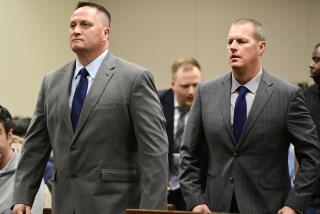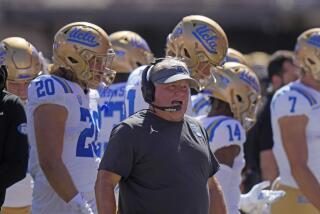Lawsuit Brings Rift in Grief : Jurisprudence: Killum’s mother sues over son’s death, leading to split with Oregon State team that mourned him.
- Share via
The last time the Oregon State basketball team was in town, its members tearfully joined Earnest Killum’s family to mourn his death from a massive stroke.
Now, the Beavers are back, but they and Killum’s family aren’t having anything to do with each other.
There was talk of playing host to Killum’s family at a dinner. The family never responded to the invitation.
There was talk of the Beavers holding a practice session at a Watts recreation center dedicated to Killum. The school couldn’t work it out.
Those who once prayed together over the body of Killum, an Oregon State guard who died here last year, have been split by a lawsuit that alleges Oregon doctors ignored tests that could have saved his life.
Killum, 20, died Jan. 20, 1992, after suffering his second stroke in six months. He had returned to the basketball court less than a month earlier, but only after doctors reduced his heart medicine.
A suit recently filed in L.A. Superior Court by his mother, Thelma Lillard, charges that if doctors had heeded the warning signs from a test taken at Harbor-UCLA Medical Center after his first stroke in July, they would not have reduced his dosage and he would be alive today.
However, a source familiar with the autopsy--which has not been made public--said that no test could have shown what eventually killed Killum: an undetectable lesion in his heart’s mitral valve that led to a clot at the base of the brain.
The mitral valve allows blood to flow freely while keeping it out of the lungs.
“What was found on his heart could only have been diagnosed post-mortem,” the source said. “And the family was explicitly informed of that.”
Bruce Mayfield, an attorney representing Lillard, declined to comment on the case.
What has resulted is an apparent split that extends to the Killum family and its circle of friends.
Earnest Killum Sr., Killum’s father, is not a plaintiff in the complaint and implied that he did not want to sue.
“I am satisfied with how it all came out,” the elder Killum said from Atlanta. “Earnest left this world doing what he wanted to do.”
Mario Jackson, Killum’s best friend and former Beaver teammate, said he was surprised by the lawsuit.
“I heard about it and I thought, ‘Wow . . . why?’ ” Jackson said from Portland. “I thought this whole thing had rested in peace, like Earnest would want it to do. I thought we could just live off his memory, and that would be the end of it.”
However, since Hank Gathers collapsed on the basketball court at Loyola Marymount University nearly three years ago, an athlete’s sudden death has often led to interpersonal conflict.
The Killum suit is part of an ever-lengthening shadow that has been cast over sports medicine since Gathers, a Loyola Marymount forward, was pronounced dead about 90 minutes after he collapsed during a postseason game in 1990. Gathers’ family sued Loyola and doctors involved in the case.
“In a lot of ways this is very similar to the Gathers case,” said David Herbert, a sports malpractice expert from Canton, Ohio, after examining the 21-page Killum suit.
“The medical problems are far different,” Herbert said. “But they are both alleging that under no circumstances should the athlete have been allowed to play.”
Although the Gathers’ family dropped the case before it reached a verdict, they received $2.4 million in settlements with Vernon Hattori, Gathers’ cardiologist, and Loyola Marymount.
Experts say that money has provided incentive for future legal action.
“Unfortunately, I think as a result of all the publicity in the Gathers’ trial, and since she (Gathers’ mother, Lucille) did have a recovery, a lot of people are more prone to suing,” said Dick Carroll, an attorney who represented the Kerlan-Jobe Orthopedic Clinic during the Gathers trial.
Carroll, who was not speaking specifically about the Killum case, added: “This is one of the reasons I wanted the Hank Gathers case to go to a verdict. I wanted to establish a standard for sports doctors. I wanted to establish that it was OK for doctors to accommodate athletes.”
The crux of the Killum suit rests in the alleged results of a transesophageal echocardiogram administered at Harbor-UCLA on July 24, 1991, one week after Killum’s first stroke. The test allows doctors to closely view the heart.
At the time, Killum, the 1990 California Divison I Player of the Year from Lynwood High, was a preparing to begin his college career after sitting out his freshman season at Oregon State because of academic problems.
According to the suit, the test revealed that Killum’s mitral valve contained bacteria and nonsupportive tissue that was prone to leakage.
A source involved with the Harbor-UCLA test confirmed those findings.
“Yes, there were those problems on the echocardiogram,” the source said. “Our recommendation to Earnest Killum was that he start taking an anticoagulant and that he does not participate in any sports.”
When the school year began, Killum was released to the care of Oregon doctors. The suit alleges that those doctors, particularly cardiologist John McAunulty of Oregon Health Sciences University hospital in Portland, did not examine the echocardiogram results.
The suit also alleges that McAunulty did not repeat the exam before deciding to lower Killum’s anticoagulant dosage three months later, which experts say might have been a serious mistake.
Speaking only about the results of the echocardiogram, David Cannom, director of cardiology at Good Samaritan Hospital, said: “If that is what it showed, then that’s a real concerning situation. That raises a lot of questions about a person’s safety.”
On Dec. 27, after much pleading from Killum, doctors reduced his dosage of Coumadin and allowed him to return to the court.
“He will always be at some risk,” Richard Cronk, Oregon State team doctor, said at the time. “But the experts have determined that the risk is in an acceptable range.”
Although Killum never signed a waiver, friends said he would have done anything to return.
“We’d be out playing games and Earnest was, like, fine,” said Canaan Chatman, Killum’s former roommate. “It seemed to us that a bunch of doctors were just being scared.
“Earnest wanted to play and, if that’s how he had to go, then that is what he wanted.”
Killum wanted to play, even though circulation problems in his legs, for which doctors could prescribe no treatment, limited his minutes.
In his final game, against USC on Jan. 16, Killum played 16 minutes, scoring 13 points. He held Harold Miner to seven second-half points after Miner had scored 30 during the first half.
But the next day, muscles in Killum’s legs were cramping, so shortly before a noon practice, he soaked them in a hotel hot tub.
It was there that he suffered the second stroke. He was found, semiconscious, with one leg in the water.
Two days later, at Daniel Freeman Memorial Hospital in Inglewood, he lapsed into a coma. He died the next afternoon.
According to the complaint, death was caused by a blood clot at the base of his brain. The suit alleges that Killum’s reduced medication gave him no protection against the clot.
Sources familiar with the autopsy, however, claim that there was no way of knowing what would eventually kill Killum.
“Even the echocardiogram done at the hospital right before his death didn’t show what was going to happen,” the source said. “The lesion was in a real hard-to-find spot.”
Rodney K. Norton, the assistant attorney general for the state of Oregon, who will act as defense counsel, agrees that his clients did nothing wrong.
“Every indication we have is that everything appropriate was done,” Norton said.
With the legal haggling expected to last for some time, the only thing that remains certain is Earnest Killum’s memory.
The Oregon State basketball players keep it alive by wearing an ‘EK’ patch on their uniforms. It will take more than a lawsuit to remove it.
Canaan Chatman, who has since transferred to Portland Community College, keeps the memory alive by wearing No. 32, Killum’s number at Oregon State.
And Bill Lee, Killum’s coach at Lynwood, keeps the memory alive by thinking about Killum’s grave in Inglewood. He has not yet visited the grave--”I just can’t bring myself to do it,” he said--but he hears it is in a wonderful spot.
“From his grave, you can stand and see the Forum,” Lee said. “Isn’t that something?”
More to Read
Sign up for Essential California
The most important California stories and recommendations in your inbox every morning.
You may occasionally receive promotional content from the Los Angeles Times.














